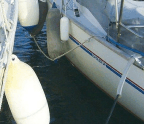TECHNICAL REMOTE MONITORING

Technology is flooding aboard our boats. From keeping an eye on your battery levels to reminding you that an item of equipment on board needs servicing, the connected boat is one of the big trends for the future. There are all sorts of claims for this technology and like everything, they need careful picking through.
At its most basic, remote monitoring has been available on boats for more than a decade. It usually consists of a black box fitted somewhere below decks with several sensors reporting into it from around the boat. These can be both wired or wireless and sometimes a blend of the two. Costs begin at £340 for the most basic C-pod unit that simply reports your GPS position. For £500-600, you can get a battery of sensors and for video imagery, you’re looking at more than £1,000.
The box takes the data gathered from the sensors and sends it via the internet to an app on your phone or tablet. Some units employ an outdated 3G mobile phone connection, which is nevertheless sufficient for transmitting small packets of simple data. Others use 4G and, no doubt, 5G in due course. Some can use marina wireless too, and even satellite communications, via a dedicated transceiver – handy in out-of-the-way places.
The sensors and the options that you pick will depend entirely on what you’re trying to achieve on board. Almost all these systems begin with a black box CPU which attaches to your house battery, typically drawing about 30mA current. That means it
You’re reading a preview, subscribe to read more.
Start your free 30 days



